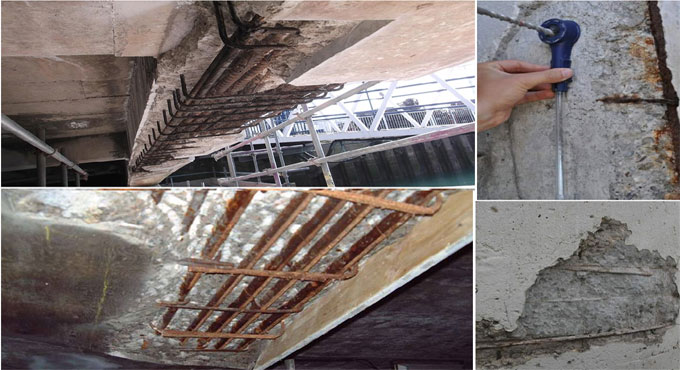
Protection from Rusting in Concrete Structures
Rusting inside the concrete of the structure is a serious matter. The steel reinforcements inside the concrete may get corroded due to rust and damage the structural integrity. Today, we will talk about protection from rusting in concrete structures.
Why is Rusting Control of Reinforcement bars (Rebars) essential?
Rusting control of steel reinforcement is important to forestall harm and disappointment of concrete structures. About 40% of disappointment of concrete structures is because of rusting of implanted steel reinforcement.
There can be numerous foundations for rusting of reinforcement, however for the most part it is identified with the nature of concrete, condition and nature of development rehearsals. Thus, the initial phase in rusting control of rebar is to give acceptable nature of concrete through great development rehearsals. The nature of concrete materials, blending, putting and compaction methods and great workmanship can help control the rebar rusting.
In spite of the fact that quality control in concrete development may lessen odds of rusting, there are different techniques by which the rusting control of reinforcement bars can be accomplished.
Strategies for rusting Control of Reinforcement in Concrete
1. Concrete Polymer Composite Coated Rebars (CPCC): Concrete polymer covered rebars inserted in concrete are encompassed by an antacid medium, hence concrete based covering is progressively good for reinforcement rusting control. Two layers of concrete polymer are applied on rebar ? Primer coat and Sealer coat.
Items engaged with Cement Polymer Composite Coated rebar are:
1. De-rusting Solution
2. Soluble Powder
3. Phosphating Jelly
4. Inhibitor Solution
5. Fixing Solution
This framework has been grown essentially as a production line/shop process.
The methodology behind improvement of this framework is that the base metal of rebars, contains pi electrons which get promptly discharged in destructive condition prompting oxidation of iron and in this way arrangement of Ferrous Oxide (II) (rust) as head impediment. So as to forestall this oxidation a surface covering equipped for collaborating/invalidating the discharged electrons is given.
Further prestressing and strengthening steel, in concrete during administration life, are presented to an antacid situation and this requires presentations of a top coat which ought to be perfect to preliminary and soluble condition.
2. Combination Bonded Epoxy Coated Rebars (FBEC): Combination fortified epoxy covered rebar is created from 100% strong finely ground intertwined powder particles. These particles liquefy to frame a persistent follower film when warmed. There is no passivating preliminary film given in the event of FBEC rebars.
Combination fortified epoxy covering presents a mechanism of shortcoming in the way of a private bond among rebar and basic concrete.
Broad examination completed on 40 scaffolds in Florida Key in USA has uncovered that disbandment can happen effectively in the FBEC rebars which needed passivation layer of Ferrous oxide (II) and is an antecedent to rusting. Higher coefficient of Thermal Expansion of combination fortified epoxies force huge warm worries in epoxy covering prompting its initial disappointment.
Epoxy covers the rebar in the accompanying way:
1. Melts
2. Streams
3. Gels
4. Fixes
5. Cools
6. Follows as covering
3. Corrosion Resistant Steel Deformed Rebars (CRSD): Components of protection from rusting start with the development of the beginning layer of defensive oxide or rust. (Hypo oxides). Not at all like basic rust on typical rebars, the CRSD rust is latent, determined and self-restoring.
The defensive oxide is finely finished, firmly disciple and a barrier to dampness, oxygen, carbon dioxide, Sulfur dioxide and chloride successfully forestalling further rusting.
Scale on ordinary bars of steel is coarse finished flaky oxide that doesn't keep dampness or oxygen from arriving at the hidden bars and proceeding with the rusting.
As rusting opposition is in the science of the evaluation, if the detached oxide layer gets expelled some way or another, another uninvolved layer is framed right away.


